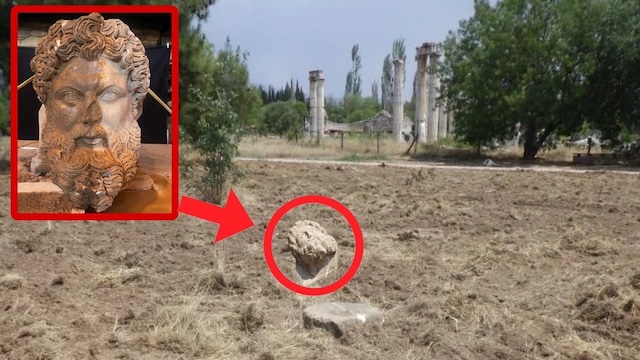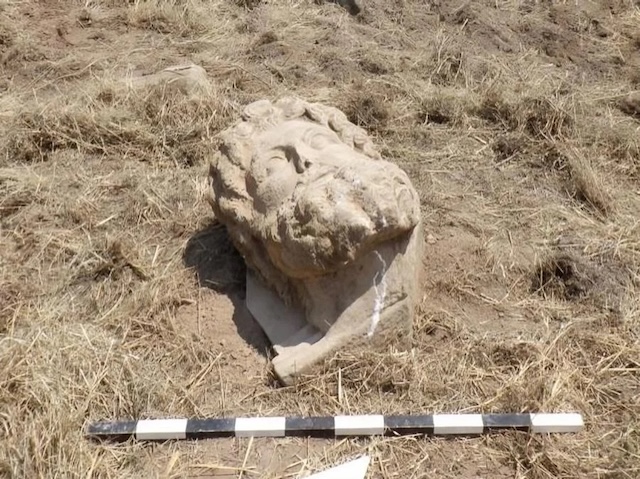Archaeologists in Turkey have made a stunning discovery in the ancient city of Aphrodisias: a colossal marble head of Zeus. This impressive artifact, which dates back to the 2nd or 3rd century CE, was found buried near the surface, and its discovery has reignited interest in the historical significance of Aphrodisias as a major center of Roman marble artistry. The find also highlights the cultural and religious importance of Zeus, the supreme god in Greek mythology.
Discovery of a Colossal Zeus Head
The marble head was found inverted, only 50 meters from the famed Temple of Aphrodite in Aphrodisias, located in Turkey’s Aydın province. Measuring 66 centimeters (about 26 inches), this large-scale artifact had been hidden just beneath the surface, where it had lain undisturbed for centuries. Its size and design suggest it may have been part of a larger architectural structure, such as an ornate console or statue pedestal.
According to Turkey’s Minister of Culture and Tourism, Mehmet Nuri Ersoy, who announced the find, this discovery is “unique” for Aphrodisias, which is already known for its wealth of Roman and Greek-era marble sculptures. The fact that the head was carved from Aphrodisias’ locally sourced marble further enhances its significance, showcasing the high-quality craftsmanship that defined the city’s artistic output.
Detailed Features of the Zeus Sculpture
The marble head, while weathered by time, retains intricate details that reflect the grandeur of Zeus in Greek mythology. The god’s thick, flowing hair and curly beard are captured in exquisite detail, revealing the level of skill and precision that the sculptor used in shaping the marble. Experts believe that the high-level sculpting techniques used, particularly in the hair and beard, demonstrate the artistic prowess of Aphrodisias’ sculptors, who were renowned for their ability to breathe life into stone.

The technique used to create this piece borrowed elements from portrait sculpture, and it’s evident that the artist aimed to give the head a more lifelike appearance. As noted by Minister Ersoy, the delicate drilling technique in the hair and beard has helped the marble capture a sense of realism that still captivates viewers thousands of years later.
The Historical and Artistic Importance of Aphrodisias
Aphrodisias, situated in the western part of Turkey, was a bustling cultural hub during the Roman period. Its proximity to high-quality marble quarries made it a renowned center for marble sculpture, and its artists were celebrated across the Roman Empire. The city’s artists were especially known for their ability to craft statues of gods and portrait sculptures that captured both Hellenistic traditions and Roman styles.
The significance of Aphrodisias lay not only in its art but also in its religious and political importance. The Temple of Aphrodite was the focal point of religious life in the city, attracting pilgrims and patrons who commissioned many of the statues and artworks that came out of its famous marble workshops. The discovery of this Zeus head serves as a reminder of the city’s status as an artistic powerhouse and its role in the dissemination of Greek and Roman religious imagery.
Remarks by Turkey’s Minister of Culture and Tourism
Minister Ersoy praised the discovery, stating that the Zeus head is a testament to the enduring craftsmanship of ancient Anatolian cultures and their contributions to global heritage. He emphasized that the marble head showcases not only the power of Zeus in Greek mythology but also the advanced techniques of Aphrodisias’ artists.
“Our efforts to carry Anatolia’s rich past to future generations will continue without slowing down,” said Minister Ersoy. His comments reflect Turkey’s ongoing commitment to preserving and studying its wealth of archaeological treasures, and to sharing these discoveries with the world.

Conservation Efforts and Further Excavations in Aphrodisias
The Zeus head has already undergone preliminary cleaning and conservation work to remove the compacted soil deposits that covered it. Given the artifact’s size and the intricate details that remain, further conservation efforts will likely be required to ensure that this monumental piece is preserved for future generations to appreciate.
Excavations in Aphrodisias are ongoing, and the discovery of the Zeus head adds to the long list of remarkable finds in the area. With each new discovery, archaeologists are uncovering more about the daily lives, religious practices, and artistic endeavors of the people who lived in this ancient city. The continuous efforts of Turkey’s Ministry of Culture and Tourism, combined with international archaeological teams, are vital to understanding Aphrodisias’ place in ancient history.
Aphrodisias: A Renowned Roman Art and Marble Sculpting Hub
Aphrodisias gained its reputation as one of the most important art centers of the Roman Empire largely because of its marble quarries and its skilled sculptors. Known for their exceptional work in the Hellenistic style, Aphrodisian sculptors were sought after for their ability to produce statues and reliefs that captured the grandeur of gods and emperors. Many of these artists were commissioned to create public works that decorated cities across the Roman world.
The newly unearthed marble head of Zeus stands as a striking example of the city’s influence and the enduring legacy of its artists. The artisans of Aphrodisias blended technical precision with a deep understanding of mythology and iconography, as seen in the magnificent rendering of Zeus, king of the gods.

Conclusion: A Discovery that Deepens Our Understanding of Aphrodisias
The marble head of Zeus, now brought into the light after centuries beneath the earth, is an extraordinary reminder of the rich history and artistic heritage of Aphrodisias. This latest discovery not only sheds light on the city’s capacity for producing masterful sculptures but also adds to the story of Zeus’s worship in the ancient world. As excavations continue and more treasures come to light, Aphrodisias’ importance as a cultural and artistic center in the Roman Empire becomes increasingly apparent.
The remarkable craftsmanship and historical significance of the Zeus head highlight the vital role Aphrodisias played in the production of marble sculptures that were revered across the ancient world. Each new discovery, such as this one, helps deepen our understanding of the past and provides us with a tangible connection to the ancient civilizations that once flourished in what is now modern-day Turkey.
